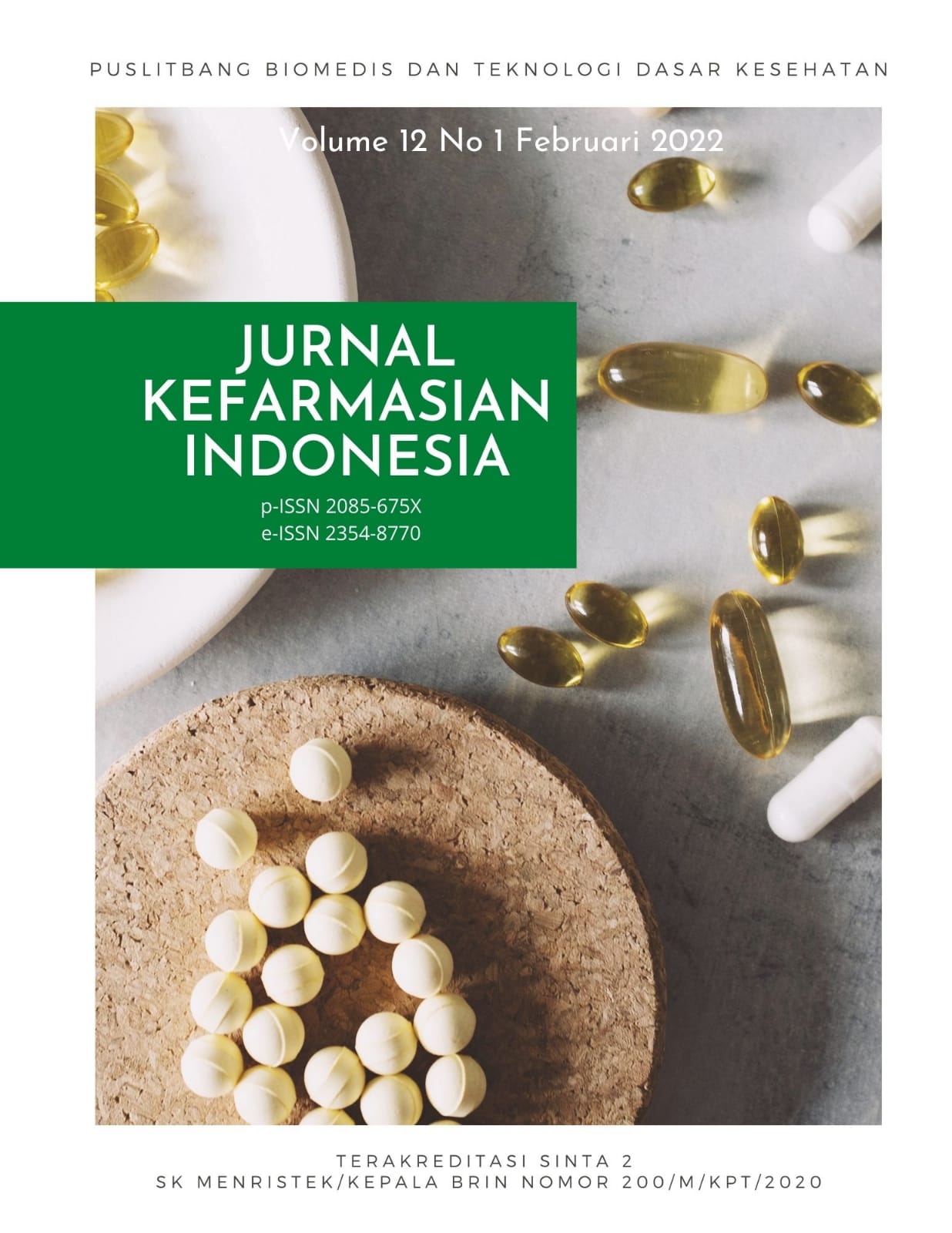Uji Aktivitas Sitotoksik Ekstrak Polar, Semipolar, dan Non-Polar Daun Sambiloto (Andrographis paniculata) terhadap Sel Kanker Hati (HepG2)
Abstract
Cancer is one of the causes of 6 major deaths in the world besides HIV, malaria, and tuberculosis. The incidence of liver cancer cases in 2018 reached 841 thousand, where there were 782 deaths. Modern medicine such as surgery, radiation, and chemotherapy has various drawbacks, high side effects, therapeutics failure, and high costs. Therefore, WHO recommends herbal medicine as a complementary therapy for various diseases, one of which is cancer. Sambiloto is one of the herbal plants that has been widely used by the people of Indonesia. The potential efficacy of sambiloto as a prospective herbal plant has been widely proven both through in vitro and in vivo studies. This study aims to determine the cytotoxic activity and IC50 value of polar, semipolar, and non-polar fractions of sambiloto leaves on HepG2 cells. Each fraction was tested for its cytotoxic activity against HepG2 cells with a concentration of 500; 250; 125; 62.5; 31.25; and 15,625 µg/mL using the MTT method. The results showed that the IC50 value for the polar, semipolar, and non-polar fractions was 82.585; 53,154; 614,349 µg / mL. Based on these results, the ethyl acetate and ethanol fractions of sambiloto leaves had strong cytotoxic activity against HepG2 cells.References
Prager GW, Braga S, Bystricky B, Qvortrup C, Criscitiello C, Esin E, et al. Global cancer control: Responding to the growing burden, rising costs and inequalities in access. ESMO Open. 1 Februari 2018;3(2):e000285.
Bray F, Ferlay J, Soerjomataram I, Siegel RL, Torre LA, Jemal A. Global cancer statistics 2018: GLOBOCAN estimates of incidence and mortality worldwide for 36 cancers in 185 countries. CA: A Cancer Journal of Clinicians. 2018;68(6):394–424. http://doi.wiley.com/10.3322/caac.21492
Dewi M. Sebaran Kanker di Indonesia, Riset Kesehatan Dasar 2007. Indonesian Journal of Cancer. 2017;11(1):1–8.
Kemenkes RI. Laporan_Nasional_RKD2018_FINAL.pdf [Internet]. Badan Penelitian dan Pengembangan Kesehatan. 2018. hal. 198.
WHO. WHO global report on traditional and complementary medicine. 2019
Sari LORK. Pemanfaatan Obat Tradisional Dengan Pertimbangan Manfaat Dan Keamanannya. Majalah Ilmu Kefarmasian. 2006;III(1):1–7.
Shofa AF, Purba AV, Setyahadi S. Interaksi ekstrak sambiloto (Andrographis paniculata (Burm.F.)Ness) dengan glibenklamid terhadap ekspresi gen CYP3A4 pada kultur sel HepG2. Jurnal Sains Farmasi dan Klinis. 2017;4(1):73–8.
Dai Y, Chen SR, Chai L, Zhao J, Wang Y, Wang Y. Overview of pharmacological activities of andrographis paniculata and its major compound andrographolide. Critical Review in Food Science and Nutrition. 2019;59(0):S17–29. http://dx.doi.org/10.1080/10408398.2018.1501657
Yang T, Yao S, Zhang X, Guo Y. Andrographolide inhibits growth of human T-cell acute lymphoblastic leukemia Jurkat cells by downregulation of PI3K/AKT and upregulation of p38 MAPK pathways. Drug Desaign Development and Therapy. 2016;10:1389–97.
Shanmugam R, Nagalingam M, Ponnanikajamideen M, Vanaja M. Anticancer Activity of Andrographis Paniculata Leaves Extract Against Neuroblastima (IMR-32) and Human Colon (HT-29) Cancer Cell Line. World Jounal of Pharmacy and Pharmaceutical Sciences. 2015;6(January):183.
Vinken M, Rogiers V, editor. Protocols in in vitro hepatocyte research: Series V.1250. New York: Heidelberg Springer; 2015
Kumar P, Nagarajan A, Uchil PD. Analysis of cell viability by the MTT assay. Cold Spring Harbor Protocols. 2018;2018(6):469–71.
Weerapreeyakul N, Nonpunya A, Barusrux S, Thitimetharoch T, Sripanidkulchai B. Evaluation of the anticancer potential of six herbs against a hepatoma cell line. Chinese Med (United Kingdom). 2012;7:1–7.
Tan WSD, Liao W, Zhou S, Wong WSF, Is there a future for andrographolide to be an anti-inflammatory drug? Deciphering its major mechanisms of action, Biochem. Pharmacol. 2017; 139: 71–81.
Ding L, Li J, Song B, Xiao X, Huang W, Zhang B, Tang X, et al. Andrographolide prevents high-fat diet-induced obesity in C57BL/6 mice by suppressing the sterol regulatory element binding protein pathway, J. Pharmacol. Exp. Therapeut. 2014; 351: 474–83.
Yang EJ, Song KS. Andrographolide, a major component of Andrographis paniculata leaves, has the neuroprotective effects on glutamate-induced HT22 cell death, J. Funct. Foods. 2014; 9: 162–72.
Zhang Z, Lai D, Wang L, Yu P, Zhu L, Guo B, et al. Neuroprotective effects of the andrographolide analogue AL-1 in the MPP(þ)/MPTP-induced Parkinson's disease model in vitro and in mice, Pharmacol. Biochem. Behav. 2014; 122: 191–202.
Islam MT, Ali ES, Uddin SJ, Islam MA, Shaw S, Khan IN, et al. Andrographolide, a diterpene lactone from Andrographis paniculata and its therapeutic promises in cancer. Cancer letters. 2018; 420: 129–45.
Copyright (c) 2022 Jurnal Kefarmasian Indonesia

This work is licensed under a Creative Commons Attribution-NonCommercial-ShareAlike 4.0 International License.














